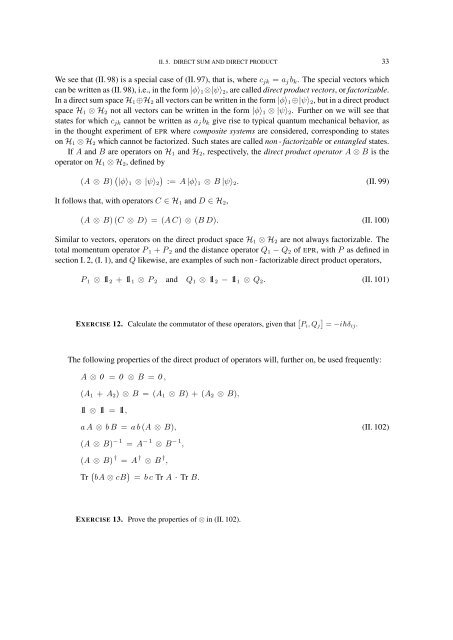FOUNDATIONS OF QUANTUM MECHANICS
FOUNDATIONS OF QUANTUM MECHANICS
FOUNDATIONS OF QUANTUM MECHANICS
You also want an ePaper? Increase the reach of your titles
YUMPU automatically turns print PDFs into web optimized ePapers that Google loves.
II. 5. DIRECT SUM AND DIRECT PRODUCT 33<br />
We see that (II. 98) is a special case of (II. 97), that is, where c jk = a j b k . The special vectors which<br />
can be written as (II. 98), i.e., in the form |ϕ⟩ 1 ⊗|ψ⟩ 2 , are called direct product vectors, or factorizable.<br />
In a direct sum space H 1 ⊕H 2 all vectors can be written in the form |ϕ⟩ 1 ⊕|ψ⟩ 2 , but in a direct product<br />
space H 1 ⊗ H 2 not all vectors can be written in the form |ϕ⟩ 1 ⊗ |ψ⟩ 2 . Further on we will see that<br />
states for which c jk cannot be written as a j b k give rise to typical quantum mechanical behavior, as<br />
in the thought experiment of EPR where composite systems are considered, corresponding to states<br />
on H 1 ⊗ H 2 which cannot be factorized. Such states are called non - factorizable or entangled states.<br />
If A and B are operators on H 1 and H 2 , respectively, the direct product operator A ⊗ B is the<br />
operator on H 1 ⊗ H 2 , defined by<br />
(A ⊗ B) ( |ϕ⟩ 1 ⊗ |ψ⟩ 2<br />
)<br />
:= A |ϕ⟩1 ⊗ B |ψ⟩ 2 . (II. 99)<br />
It follows that, with operators C ∈ H 1 and D ∈ H 2 ,<br />
(A ⊗ B) (C ⊗ D) = (A C) ⊗ (B D). (II. 100)<br />
Similar to vectors, operators on the direct product space H 1 ⊗ H 2 are not always factorizable. The<br />
total momentum operator P 1 + P 2 and the distance operator Q 1 − Q 2 of EPR, with P as defined in<br />
section I. 2, (I. 1), and Q likewise, are examples of such non - factorizable direct product operators,<br />
P 1 ⊗ 11 2 + 11 1 ⊗ P 2 and Q 1 ⊗ 11 2 − 11 1 ⊗ Q 2 . (II. 101)<br />
EXERCISE 12. Calculate the commutator of these operators, given that [ P i , Q j<br />
]<br />
= −iδij .<br />
The following properties of the direct product of operators will, further on, be used frequently:<br />
A ⊗ 0 = 0 ⊗ B = 0 ,<br />
(A 1 + A 2 ) ⊗ B = (A 1 ⊗ B) + (A 2 ⊗ B),<br />
11 ⊗ 11 = 11,<br />
a A ⊗ b B = a b (A ⊗ B), (II. 102)<br />
(A ⊗ B) − 1 = A − 1 ⊗ B − 1 ,<br />
(A ⊗ B) † = A † ⊗ B † ,<br />
Tr ( bA ⊗ cB ) = b c Tr A · Tr B.<br />
EXERCISE 13. Prove the properties of ⊗ in (II. 102).
















